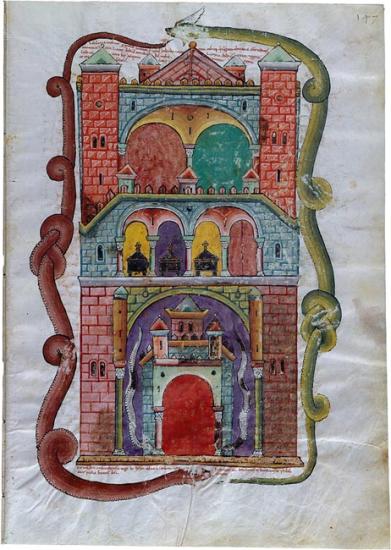
City of Babylon Surrounded by Serpents
Beatus of Liébana
Las Huelgas Apocalypse
Purchased by Pierpont Morgan, 1910
This miniature of Babylon functioned as a frontispiece to the Book of Daniel. It was from Babylon that Nebuchadnezzar came and besieged Jerusalem. The entire city of Babylon is surrounded by two enormous serpents whose heads and tails fall on the central axis. Two more serpents flank the large doorway at bottom. Above the door an arcade houses the silver coffins of the three Jews who were saved from the burning furnace; they are identified by the inscription at top as Hananiah, Mishael, and Azariah (and were worshiped as saints in Spain). The inscription below relates how Nebuchadnezzar took vessels from the temple of Jerusalem and how the wrath of God inflicted dragons, ostriches, and seductively singing owls and sirens on the city. Such accounts may have been inspired by the protective reliefs of dragons on Babylon's famous Ishtar Gate.
BOOK OF DANIEL
Although it was once thought that the author was Daniel, a Jewish exile in Babylon in the sixth century B.C., most scholars agree the book was written between 168 and 165 B.C. in support of Jews persecuted by the Seleucid emperor, Antiochus IV Epiphanes. The book was used as a pattern for later Jewish and Christian apocalypses, including the present Apocalypse of John, which also told of the fall of Babylon and the coming of Christ and his church. The Daniel cycle was added to Beatus manuscripts about 945, the same time that Maius introduced the prefatory cycle. The artist responsible for the eleven miniatures of the Las Huelgas Daniel cycle is called the Master of Toledo, after the city where he painted both manuscripts and frescoes. He participated in a copy of St. Ildefonsus's Treatise on the Virginity of Mary, now in Madrid (cod. 10087), and in wall paintings at the Basilica of Santa Cruz in Toledo. The Daniel cycle, however, was not invented for this manuscript but derives from earlier illustrated Bibles.
The Apocalypse, or Book of Revelation, is not only the last Book of the New Testament, but its most difficult, puzzling, and terrifying. It provided challenges to medieval illustrators and was the source for a number of popular images, such as Christ in Majesty, the Adoration of the Lamb, and the Madonna of the Apocalypse and contributed to the widespread use of the Evangelists' symbols.
Selected images from Apocalypse Then: Medieval Illuminations from the Morgan, an exhibition held at the Morgan are presented here. The exhibition celebrates the completion of a facsimile of the Morgan's Las Huelgas Apocalypse—the latest dated (1220) and largest surviving manuscript of a Spanish tradition of illuminated commentaries on the Apocalypse by the monk Beatus of Liébana. The series of manuscripts constitutes Spain's most important contribution to medieval manuscript illumination.
The Las Huelgas Apocalypse contains three sections: the prefatory cycle, the Apocalypse, and the Book of Daniel.
In addition to forty-nine images from the Las Huelgas Apocalypse, six images from other manuscripts in the Morgan's collections, including the earliest Beatus painted by Maius and one by the Master of the Berry Apocalypse, are in this presentation.
